Related Research Articles

The Science and Industry Museum in Manchester, England, traces the development of science, technology and industry with emphasis on the city's achievements in these fields. The museum is part of the Science Museum Group, a non-departmental public body of the Department for Digital, Culture, Media and Sport, having merged with the National Science Museum in 2012.

Birmingham Museum and Art Gallery (BM&AG) is a museum and art gallery in Birmingham, England. It has a collection of international importance covering fine art, ceramics, metalwork, jewellery, natural history, archaeology, ethnography, local history and industrial history.
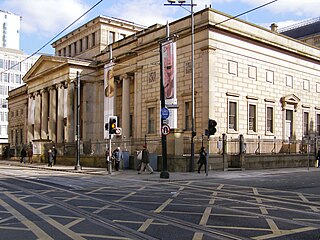
Manchester Art Gallery, formerly Manchester City Art Gallery, is a publicly owned art museum on Mosley Street in Manchester city centre, England. The main gallery premises were built for a learned society in 1823 and today its collection occupies three connected buildings, two of which were designed by Sir Charles Barry. Both of Barry's buildings are listed. The building that links them was designed by Hopkins Architects following an architectural design competition managed by RIBA Competitions. It opened in 2002 following a major renovation and expansion project undertaken by the art gallery.
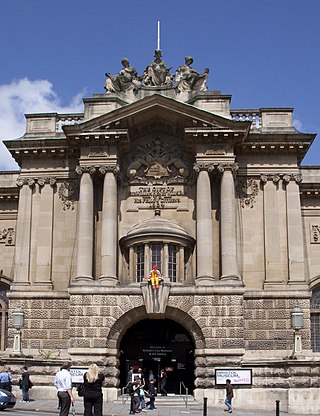
Bristol Museum & Art Gallery is a large museum and art gallery in Bristol, England. The museum is situated in Clifton, about 0.5 miles (0.8 km) from the city centre. As part of Bristol Culture it is run by the Bristol City Council with no entrance fee. It holds designated museum status, granted by the national government to protect outstanding museums. The designated collections include: geology, Eastern art, and Bristol's history, including English delftware. In January 2012 it became one of sixteen Arts Council England Major Partner Museums.

The Carnegie Museum of Art is an art museum in the Oakland neighborhood of Pittsburgh, Pennsylvania. The museum was originally known as the Department of Fine Arts, Carnegie Institute and was formerly located at what is now the Main Branch of the Carnegie Library of Pittsburgh. The museum's first gallery was opened for public use on November 5, 1895. Over the years, the gallery vastly increased in size, with a new building on Forbes Avenue built in 1907. In 1963, the name was officially changed to Museum of Art, Carnegie Institute. The size of the gallery has tripled over time, and it was officially renamed in 1986 to "Carnegie Museum of Art" to indicate it clearly as one of the four Carnegie Museums.

Ancoats is an area of Manchester, England, next to the Northern Quarter, the northern part of Manchester city centre.

The Northern Quarter is an area of Manchester city centre, England, between Piccadilly station, Victoria station and Ancoats, centred on Oldham Street, just off Piccadilly Gardens. It was defined and named in the 1990s as part of the regeneration and gentrification of Manchester.
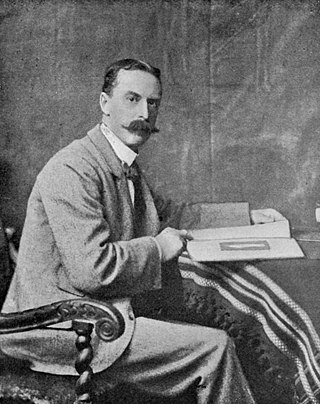
Edmund Blair Leighton was an English painter of historical genre scenes, specialising in Regency and medieval subjects. His art is associated with the pre-Raphaelite movement of the mid-to-late nineteenth and early twentieth centuries.

The Ancoats Hospital and Ardwick and Ancoats Dispensary was a large inner-city hospital located in Ancoats, to the north of the city centre of Manchester, England. It was built in 1875, replacing the Ardwick and Ancoats Dispensary that had existed since 1828. The building is now Grade II listed.
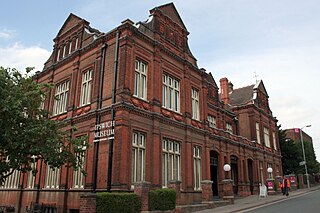
Ipswich Museum is a registered museum of culture, history and natural heritage, located in a Grade II* listed building on High Street in Ipswich, the county town of Suffolk. It was historically the leading regional museum in Suffolk, housing collections drawn from both the former counties of East Suffolk and West Suffolk, which were amalgamated in 1974.

The Culture of Manchester is notable artistically, architecturally, theatrically and musically. Despite being the 5th largest city in the United Kingdom by population and the second largest conurbation, Manchester has been ranked as the second city of the United Kingdom in numerous polls since the 2000s (decade), with an influential culture scene helping to elevate Manchester's importance in the national psyche. This has helped the city's population grow by 20% in the last decade, and made the universities the most popular choices for undergraduate admission.

The architecture of Manchester demonstrates a rich variety of architectural styles. The city is a product of the Industrial Revolution and is known as the first modern, industrial city. Manchester is noted for its warehouses, railway viaducts, cotton mills and canals – remnants of its past when the city produced and traded goods. Manchester has minimal Georgian or medieval architecture to speak of and consequently has a vast array of 19th and early 20th-century architecture styles; examples include Palazzo, Neo-Gothic, Venetian Gothic, Edwardian baroque, Art Nouveau, Art Deco and the Neo-Classical.
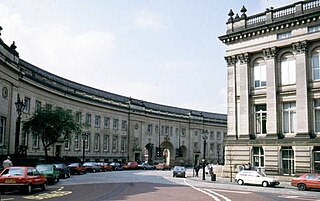
Bolton Museum is a public museum, aquarium and art gallery in the town of Bolton, England, owned by Bolton Metropolitan Borough Council. The museum is housed within the grade II listed Le Mans Crescent near Bolton Town Hall and shares its main entrance with the central library in a purpose-built civic centre.
The Art Treasures of Great Britain was an exhibition of fine art held in Manchester, England, from 5 May to 17 October 1857. It remains the largest art exhibition to be held in the UK, possibly in the world, with over 16,000 works on display. It attracted over 1.3 million visitors in the 142 days it was open, about four times the population of Manchester at that time, many of whom visited on organised railway excursions. Its selection and display of artworks had a formative influence on the public art collections that were then being established in the UK, such as the National Gallery, National Portrait Gallery and the Victoria and Albert Museum.

Hove Museum of Creativity is a municipally-owned museum in the town of Hove, which is part of the larger city of Brighton and Hove in the South East of England. The museum is part of Brighton & Hove Museums, and admission is free. Opened in 1927 by the Hove Corporation, the museum is located in a late 19th-century villa originally known as Brooker Hall.
Leeds is known for its culture in the fields of art, architecture, music, sport, film and television. As the largest city in Yorkshire, Leeds is a centre of Yorkshire's contemporary culture and is the base for Yorkshire's television and regional newspapers.
Thomas Coglan Horsfall (1841–1932) was a noted philanthropist, town planner, writer and founder of the Manchester Art Museum in Ancoats Hall.
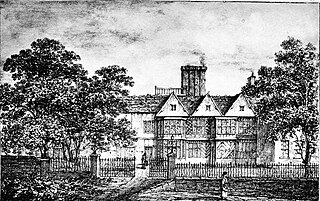
Ancoats Hall in Ancoats, Manchester, England, was a post-medieval country house built in 1609 by Oswald Mosley, a member of the Mosley family, Lords of the Manor of Manchester. The old timber-framed hall, built in the early 17th century, was described by John Aiken in his 1795 book Description of the country from 30 to 40 miles around Manchester. The old hall was demolished in the 1820s and replaced by a brick building in the early neo-Gothic style. The new hall, at the eastern end of Great Ancoats Street, between Every Street and Palmerston Street, was demolished in the 1960s.
David Henry Parry was a British portrait painter. He was the son of Joseph Parry and brother of James Parry, both also artists.
References
- 1 2 "Eagles, Stuart (2009) 'Thomas Coglan Horsfall, and Manchester Art Museum and University Settlement', the encyclopaedia of informal education". infed.org. Retrieved 13 October 2014.
- 1 2 3 Wilson, Shelagh, "The Highest Art for the lowest People: The Whitechapel and Other Philanthropic Art Galleries, 1877-1901", Governing Cultures, Ashgate, 2000, pp.172-86.
- ↑ Manchester City Galleries – History of the Collection
- ↑ s:The Times/1932/Obituary/Thomas Coglan Horsfall
- ↑ "Manchester City Galleries - Art for All: Thomas Horsfall's Gift to Manchester". Archived from the original on 19 December 2013. Retrieved 12 March 2014.
- ↑ Harrison, M. (1985). Art and philanthropy: TC Horsfall and the Manchester Art Museum. City, Class and Culture, 120-47.
- ↑ Harrison, M. (1993). Art and Social Regeneration: The Ancoats Art Museum. Manchester Regional History Review, 4, 63-72.